Method and Device for Measuring the Diameter at Breast Height and Location of Trees in Sample Plots
Abstract
:1. Introduction
2. Material and Methods
2.1. Mechanical Structural Design
2.2. System Process
2.3. DBH Measurement Algorithm
2.4. Tree-Position Measurement Algorithm
2.5. Experimental Process
- Data were collected from the gyroscope and compass modules on the base station, with base stations B, C, D and E on the same plane, and base station B was pointed due north at the correct location within the sample plot, as shown in Figure 6.
- The sample plot number on the function interface of the DBH measurement instrument was set.
- Based on the data of the compass module of the measurement instrument, the DBH of each tree within the sample plot was measured. Subsequently, the location information was acquired. (The DBH and location measurements are shown in Figure 7).
- Upon completing the measurement, the data were uploaded to the upper computer for statistical analysis.
3. Results
3.1. Experimental Location and Objects
3.2. Similarity Estimation
3.3. DBH Evaluation
3.4. Location Evaluation
3.5. Measurement Efficiency Evaluation
4. Discussion
5. Conclusions
Author Contributions
Funding
Data Availability Statement
Conflicts of Interest
References
- Zhang, H.R.; Lei, X.D.; Li, F.R. Research Progress and Prospects of Forest Management Science in China. Sci. Silv. Sin. 2020, 56, 130–142. [Google Scholar]
- Yang, Z.; Liu, Q.; Luo, P.; Ye, Q.; Duan, G.; Sharma, R.P.; Zhang, H.; Wang, G.; Fu, L. Prediction of Individual Tree Diameter and Height to Crown Base Using Nonlinear Simultaneous Regression and Airborne LiDAR Data. Remote Sens. 2020, 12, 2238. [Google Scholar] [CrossRef]
- Sun, L.; Fang, L.; Fang, Y.; Weng, Y.; Lou, X. Development of DBH Measurement Device Using Capacitive Gate Sensor. Chin. J. Sens. Actuators 2019, 32, 1435–1442. [Google Scholar]
- Sun, L.; Fang, L.; Tang, L.; Liu, J. Developing portable system for measuring diameter at breast height. J. Beijing For. Univ. 2018, 40, 82–89. [Google Scholar] [CrossRef]
- Fan, G.; Nan, L.; Chen, F.; Dong, Y.; Wang, Z.; Li, H.; Chen, D. A New Quantitative Approach to Tree Attributes Estimation Based on Lidar Point Clouds. Remote Sens. 2020, 12, 1779. [Google Scholar] [CrossRef]
- Liu, J.; Liang, X.; Hyyppä, J.; Yu, X.; Lehtomäki, M.; Pyörälä, J.; Zhu, L.; Wang, Y.; Chen, R. Automated Matching of Multiple Terrestrial Laser Scans for Stem Mapping without the Use of Artificial References. Int. J. Appl. Earth Obs. Geoinf. 2017, 56, 13–23. [Google Scholar] [CrossRef]
- Mokroš, M.; Liang, X.; Surový, P.; Valent, P.; Čerňava, J.; Chudý, F.; Tunák, D.; Saloň, Š.; Merganič, J. Evaluation of Close-Range Photogrammetry Image Collection Methods for Estimating Tree Diameters. ISPRS Int. J. Geo-Inf. 2018, 7, 93. [Google Scholar] [CrossRef]
- Hyyppä, J.; Virtanen, J.P.; Jaakkola, A.; Yu, X.; Hyyppä, H.; Liang, X. Feasibility of Google Tango and Kinect for Crowdsourcing Forestry Information. Forests 2017, 9, 6. [Google Scholar] [CrossRef]
- Fan, Y.; Feng, Z.; Chen, P.; Gao, X.; Shen, C. Research on Forest Plot Survey System Based on RGB-D SLAM Mobile Phone. Trans. Chin. Soc. Agric. Mach. 2019, 50, 226–234. [Google Scholar] [CrossRef]
- Liu, J.C.; Feng, Z.K.; Yang, L.Y.; Mannan, A. Design of real-time kinematic multi-functional binocular stereo-photogrammetric dendrometer. Trans. Chin. Soc. Agric. Eng. 2018, 34, 61–68. [Google Scholar]
- Zhao, P. Research on Key Technologies of 3D Modeling and Semantic Segmentation for Indoor and Outdoor Scenes; Wuhan University: Wuhan, China, 2020. [Google Scholar]
- Han, G.; Wang, G.; Zhang, Z.; Li, Q.; Xue, Q. Population Structure of the Pinus thumbergii Coastal Protection Forest and Its Spatial Variation at Different Distances to Coastline in Yantai. Sci. Silv. Sin. 2007, 44, 8–13. [Google Scholar] [CrossRef]
- Yuan, F.; Fang, L.; Sun, L.; Zheng, S.; Zheng, X. Development of a portable measuring device for diameter at breast height and tree height. Austrian J. For. Sci. 2021, 138, 25–50. [Google Scholar]
- Li, S.; Fang, L.; Sun, Y.; Xia, L.; Lou, X. Development of Measuring Device for Diameter at Breast Height of Trees. Forests 2023, 14, 192. [Google Scholar] [CrossRef]
- Liang, X.; Kukko, A.; Hyyppä, J.; Lehtomäki, M.; Pyörälä, J.; Yu, X.; Kaartinen, H.; Jaakkola, A.; Wang, Y. In situ Measurements from Mobile Platforms: An Emerging Approach to Address the Old Challenges Associated with Forest Inventories. ISPRS J. Photogramm. Remote Sens. 2018, 143, 97–107. [Google Scholar] [CrossRef]
- Hao, Y.Q. Preview of Spatial Structure of Cryptomeria fortunei Plantation after Stand Improvement. Sci. Silv. Sin. 2006, 42, 8–13. [Google Scholar]
- Oveland, I.; Hauglin, M.; Gobakken, T.; Næsset, E.; Maalen-Johansen, I. Automatic Estimation of Tree Position and Stem Diameter Using a Moving Terrestrial Laser Scanner. Remote Sens. 2017, 9, 350. [Google Scholar] [CrossRef]
- Mona, F.; Niclas, B.; Johan, H. Error analysis of measuring height and volume of standing tree with total station. Trans. Chin. Soc. Agric. Eng. 2016, 32, 160–167. [Google Scholar]
- Zhao, H.; Feng, H.; Ding, L.; Cheng, H. Research on a Novel Hall Angle Sensor. Acta Metrol. Sin. 2018, 39, 797–800. [Google Scholar]
- Haglöf Company Group. MD II Caliper Product Sheet [EB/OL]. Available online: https://haglofsweden.com/products/calipers/ (accessed on 17 August 2023).
- Sun, L.; Fang, L.; Weng, Y.; Zheng, S. An Integrated Method for Coding Trees, Measuring Tree Diameter, and Estimating Tree Positions. Sensors 2020, 20, 144. [Google Scholar] [CrossRef]
- Wang, L.; Hu, Z.; Guan, M.; Wu, J.; Xian, D.; Wang, C.; Mao, Q.; Wang, G.; Zhou, Z.; Tian, B.; et al. Research Progress of Magnetic Field Sensors Based on GMR Effect. Instrum. Tech. Sens. 2021, 12, 1–12+17. [Google Scholar]
- Liu, Z.; Zhang, J.; Fu, Z.; Zhu, C. Research on Angle Measurement Technology of High Voltage Disconnector Based on Optical Fiber Angle Sensor. High Volt. Appar. 2021, 57, 9–17. [Google Scholar]
- Liao, T.; Wu, X.; Zhao, L.; Jin, X.; Jia, Z.; Dai, Y. UWB/IMU indoor combination positioning algorithm based on improved MCKF. Transducer Microsyst. Technol. 2022, 41, 127–130. [Google Scholar] [CrossRef]
- Nan, J.; Han, X.; Gao, M.; Wang, M.; Wang, Y.; Wang, J. Design of miniaturized Uwb-Mimo antenna based on DGS. J. Electron. Meas. Instrum. 2022, 36, 89–95. [Google Scholar]
- Zhao, Y.; Zhou, J.; Cai, L.; Huang, G. An ultra wide band indoor positioning method considering electrical delay. Bull. Surv. Mapp. 2022, 1, 1–5+31. [Google Scholar] [CrossRef]
- Luo, P.; Hu, Z.; Tian, S.; Liu, M. The Status and Trends of UWB Radar Integrated Circuit. J. Electron. Inf. Technol. 2022, 44, 1176–1192. [Google Scholar]
- Li, Y.; Zhang, X. A Method of Measuring Angle by Using Hall Sensor. Electro-Mech. Eng. 2001, 4, 25–26. [Google Scholar] [CrossRef]
- Li, R.; Wang, N.; Liu, J.; Wang, Z. UWB ranging error estimation and compensation method for relative navigation. Chin. J. Sci. Instrum. 2019, 40, 28–35. [Google Scholar]
- Linnainmaa, S. Taylor expansion of the accumulated rounding error. BIT Numer. Math. 1976, 16, 146–160. [Google Scholar] [CrossRef]

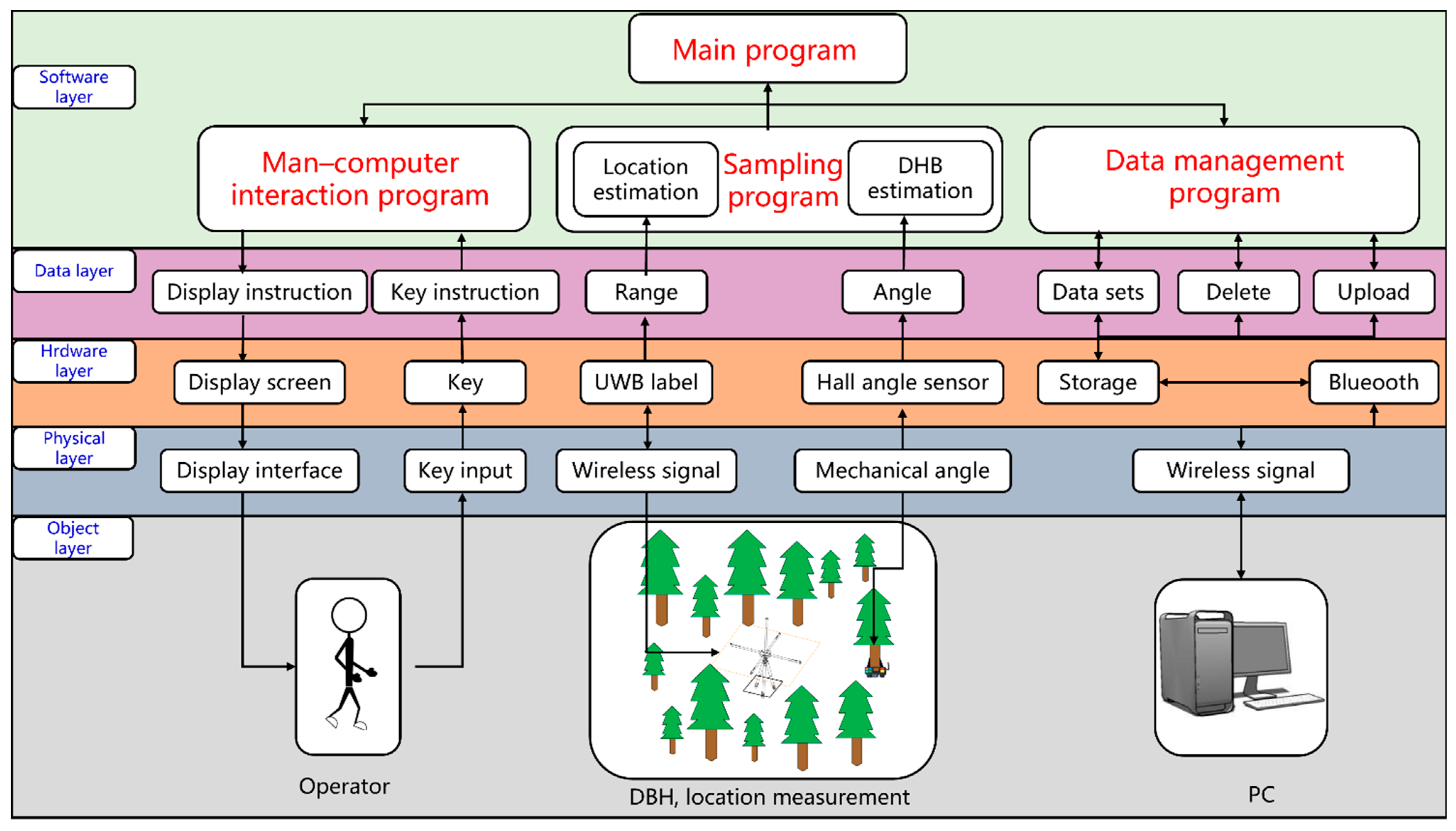
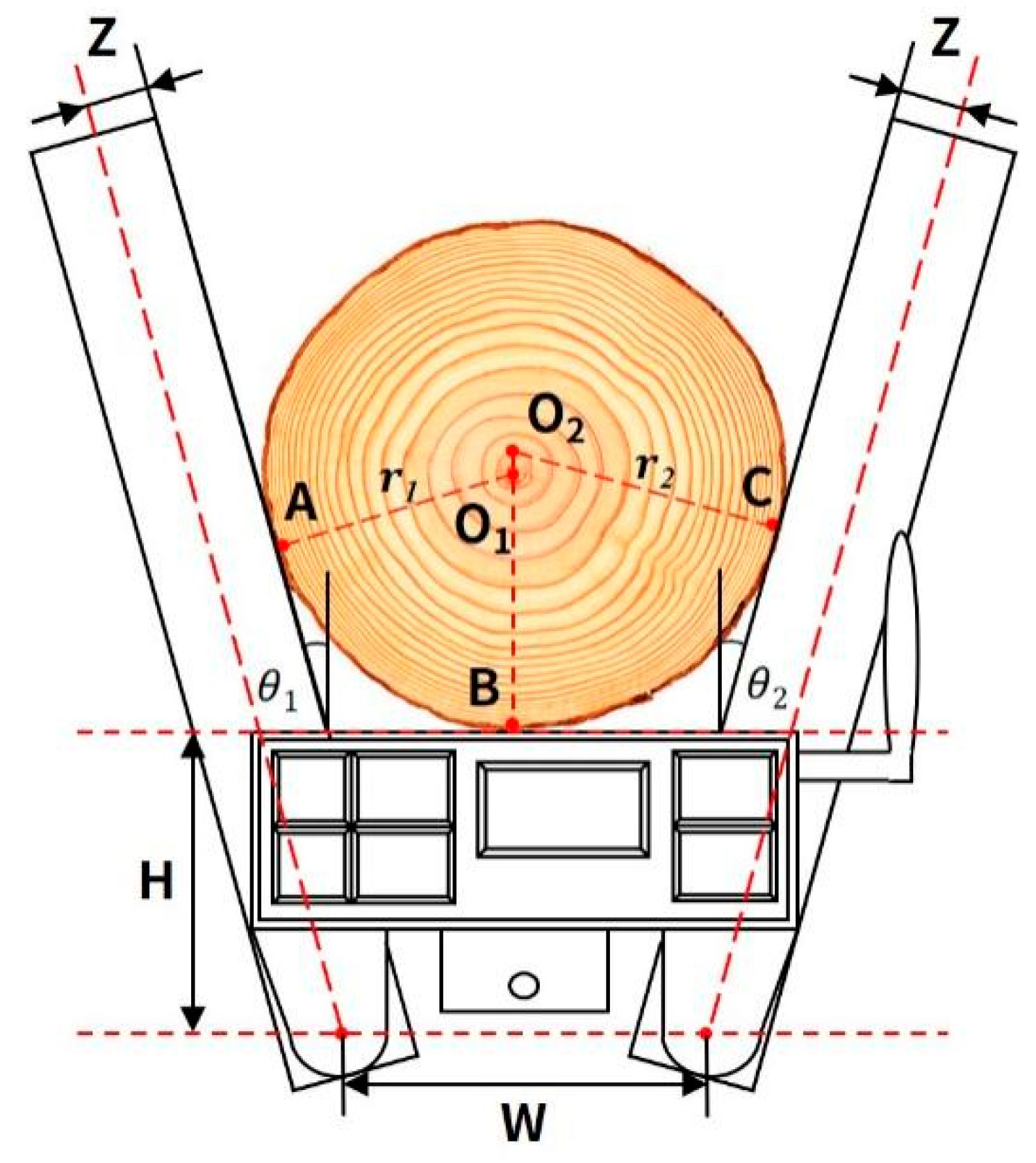

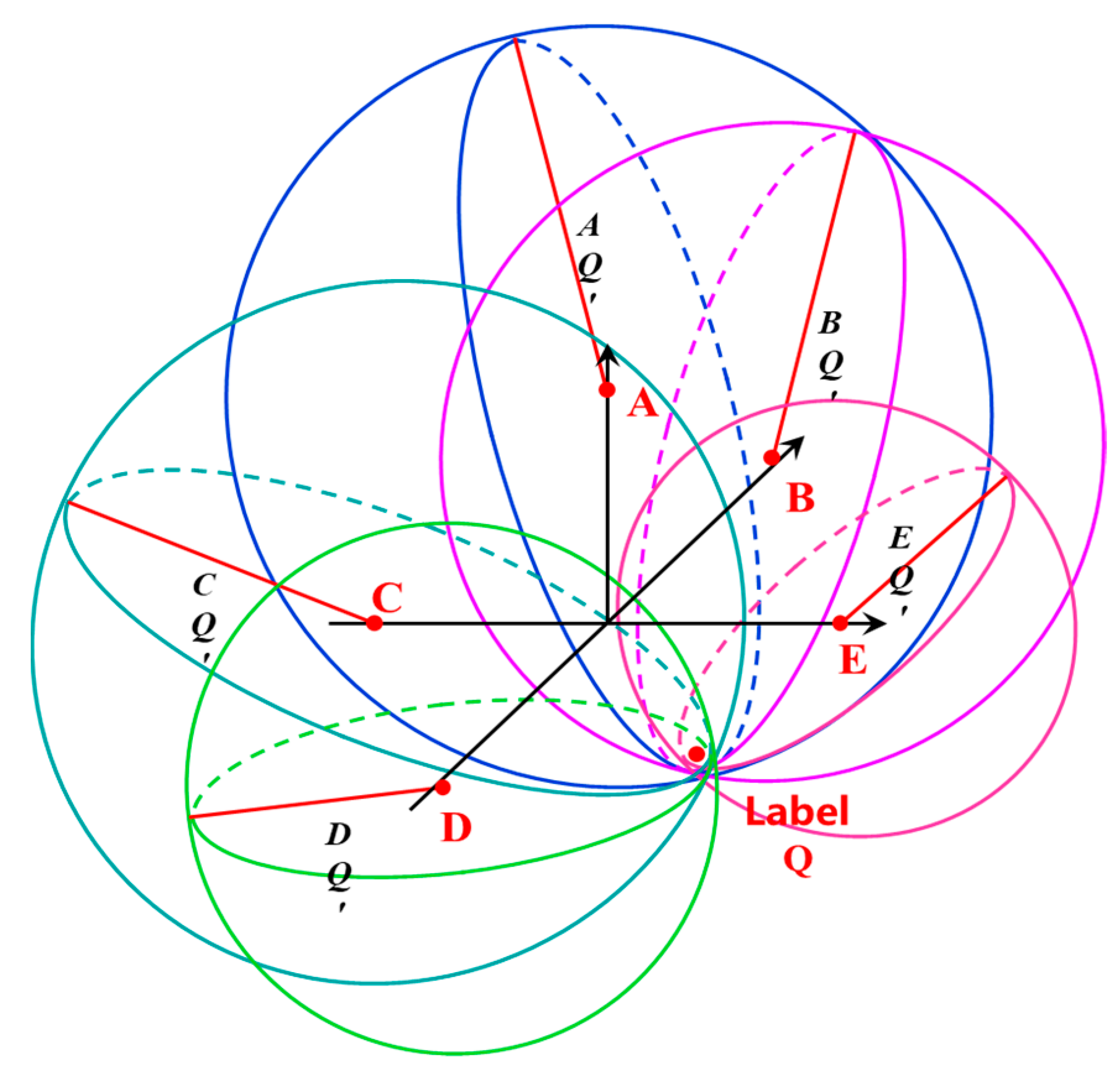
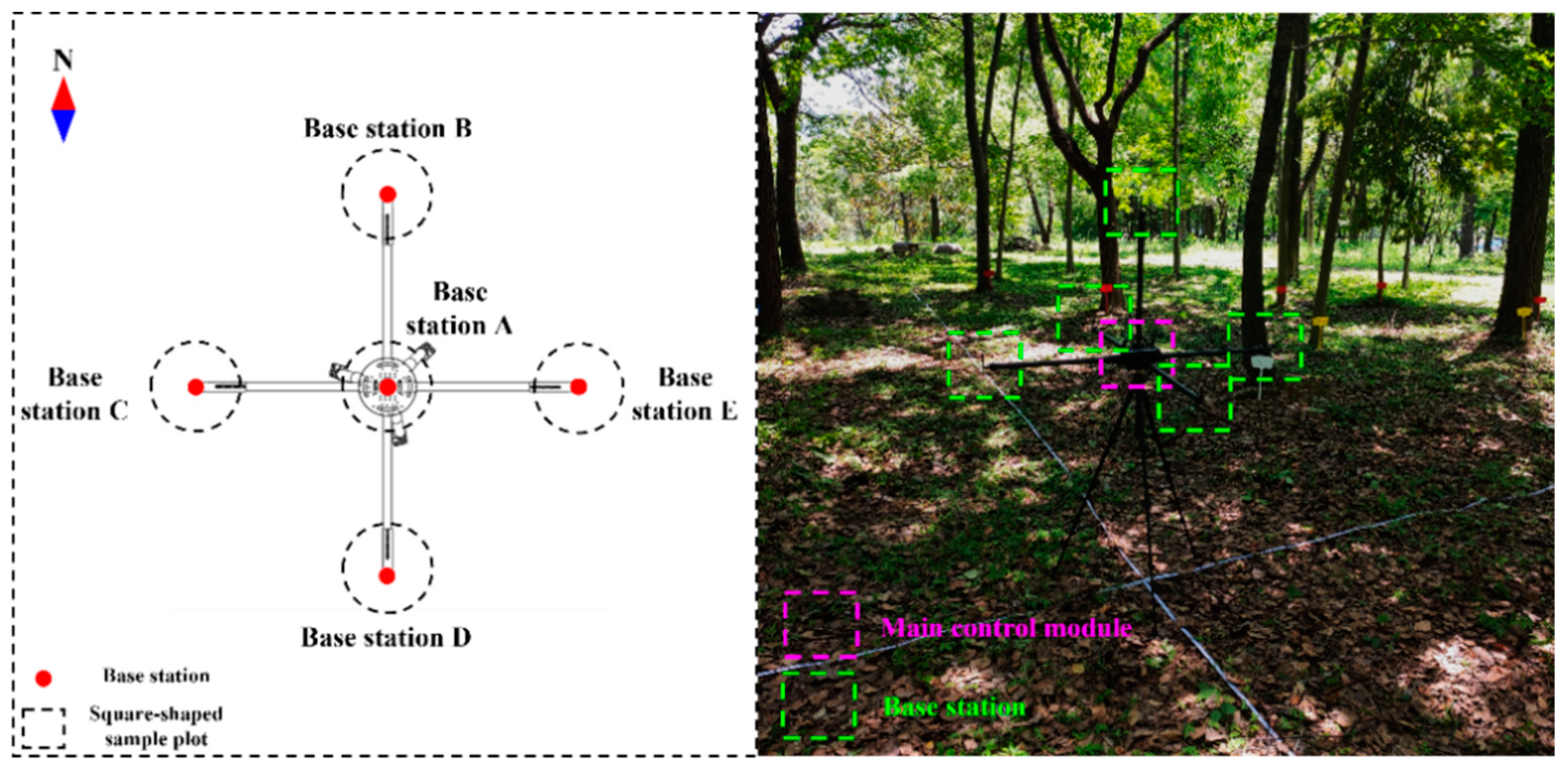
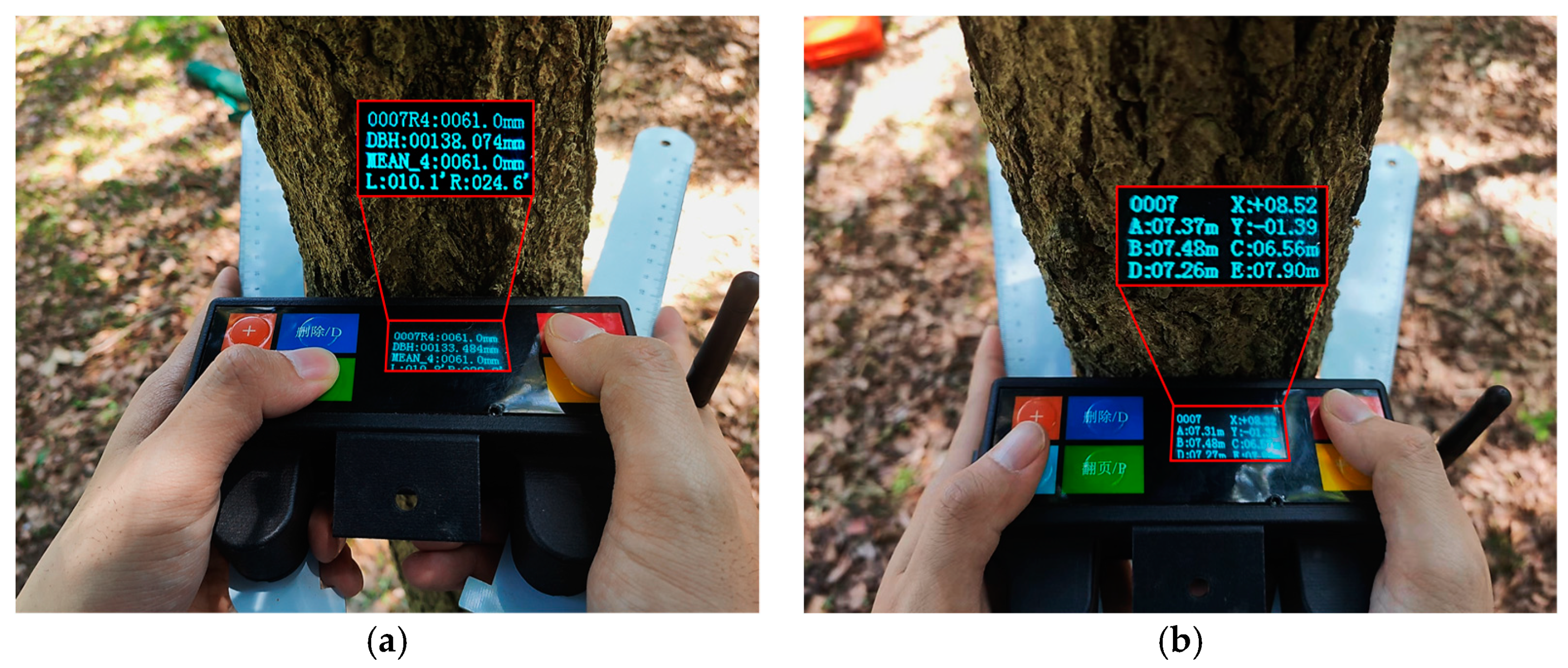
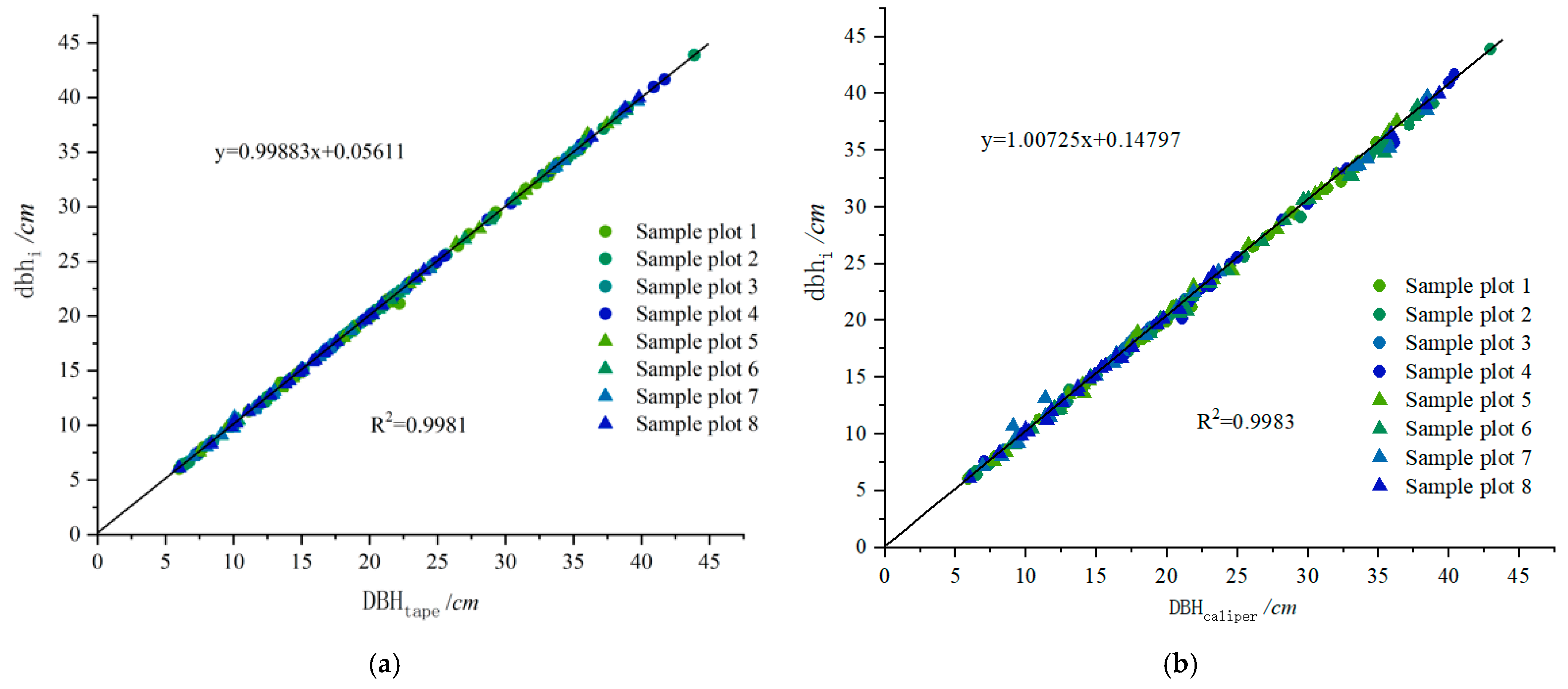
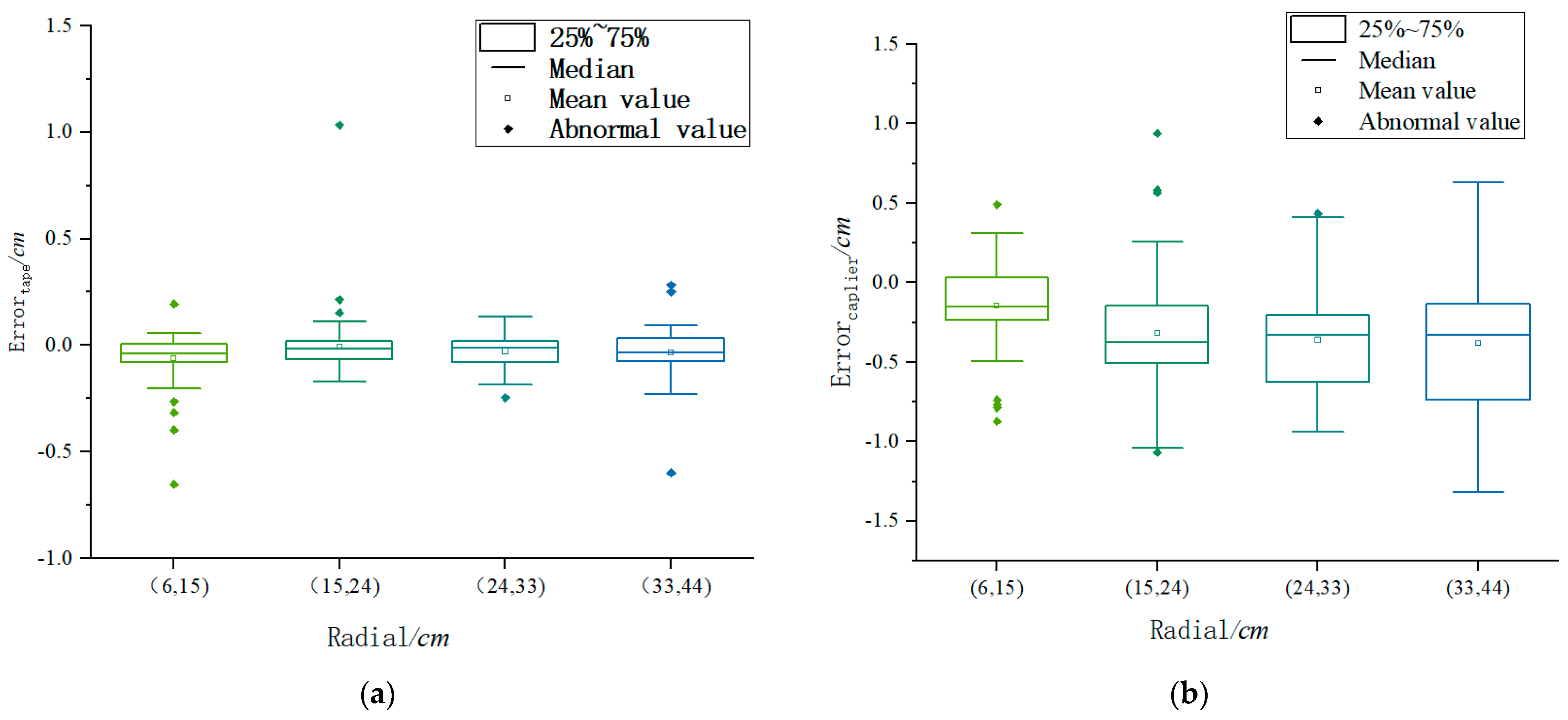

| Component | Chip Interface/Type | Interface Type | Quantity | Parameter | Function |
|---|---|---|---|---|---|
| Microprocessor | STC15W4K56S4 | IO port, SPI, etc. | 2 | SRAM: 4 KB; Flash: 56 KB | Data processing |
| Power-supply-management circuit | TP4056, AMS1117, etc. | DC voltage | 2 | Input: 3.7 V–5 V; Output: 5 V, 3.3 V | Power-supply-management |
| battery | Lithium–ion battery | DC 5.5–2.1 | 2 | 4000 mAh | Power supply |
| Gyroscope module | JY901B | Serial port | 1 | Measurement accuracy | Attitude measurement |
| Compass module | GY-26 | Serial port | 2 | Measurement accuracy: 0.1° | Azimuth angle measurement |
| UWB module | D-DWM-PG1.7 | Serial port | 6 | Measurement accuracy: 1 cm Measurement range: 0–150 m | Distance measurement |
| Hall-effect angle-position sensor | TM003A | Serial port | 1 | Measurement accuracy: 0.01 mm | Angle measurement |
| Analogue–digital converting module | ADS1115 | I2C | 1 | 16-bit, 4-channel | Analogue–digital conversion |
| Membrane key | PVC | Digital signal | 1 | 6 keys | Data recording |
| Display screen | OLED | SPI | 2 | 128 × 64 pixels | Data display |
| Bluetooth | HC-06 | Serial port | 1 | Communication distance | Upper computer communication |
| SD card | MicroSD | SPI | 1 | 2 GB | Data storage |
| Plot No. | Number of Trees | Species * | Slope (°) | DBH (cm) | ||
|---|---|---|---|---|---|---|
| Min Value | Max Value | Mean | ||||
| 1 | 27 | S3, S4 | 3.2 | 6.01 | 35.65 | 22.25 |
| 2 | 28 | S1, S3, S4, S5, | 4.7 | 6.20 | 43.90 | 26.94 |
| 3 | 19 | S2 | 1.1 | 8.50 | 22.00 | 17.76 |
| 4 | 23 | S3, S5, S6 | 3.9 | 7.45 | 41.70 | 25.35 |
| 5 | 25 | S3, S4 | 5.3 | 7.5 | 37.48 | 21.59 |
| 6 | 27 | S1, S2, S3 | 12.5 | 9.08 | 38.88 | 22.83 |
| 7 | 26 | S3, S4, S5, | 15.6 | 7.00 | 39.72 | 19.60 |
| 8 | 25 | S1, S3, S4, S7 | 19.7 | 6.00 | 39.80 | 19.75 |
| Plot No. | DHB Tape | Calliper | ||||||||
|---|---|---|---|---|---|---|---|---|---|---|
| BIAS (cm) | relBIAS (%) | RMSE (cm) | relRMSE (%) | relAcc (%) | BIAS (cm) | relBIAS (%) | RMSE (cm) | relRMSE (%) | RelAcc (%) | |
| 1 | −0.02 | −0.06 | 0.25 | 1.29 | 98.71 | −0.20 | −1.10 | 0.34 | 1.79 | 98.21 |
| 2 | −0.01 | −0.12 | 0.06 | 0.70 | 99.30 | −0.13 | −0.68 | 0.29 | 1.73 | 98.27 |
| 3 | −0.02 | −0.12 | 0.05 | 0.35 | 99.65 | −0.47 | −2.63 | 0.50 | 2.77 | 97.23 |
| 4 | −0.05 | −0.07 | 0.06 | 0.28 | 99.72 | −0.35 | −1.44 | 0.55 | 2.38 | 97.62 |
| 5 | −0.07 | −0.39 | 0.15 | 0.75 | 99.25 | −0.45 | −1.83 | 0.63 | 2.88 | 97.12 |
| 6 | −0.03 | −0.16 | 0.06 | 0.36 | 99.64 | −0.20 | −0.82 | 0.45 | 1.79 | 98.21 |
| 7 | −0.10 | −0.48 | 0.16 | 1.43 | 98.57 | −0.34 | −2.15 | 0.63 | 4.61 | 95.39 |
| 8 | −0.07 | −0.47 | 0.11 | 0.88 | 99.12 | −0.33 | −1.86 | 0.41 | 2.22 | 97.78 |
| Total | −0.03 | −0.24 | 0.13 | 0.60 | 99.40 | −0.29 | −1.43 | 0.46 | 1.75 | 98.25 |
| Plot No. | ED (cm) | |||
|---|---|---|---|---|
| Mean (cm) | Max (cm) | Min (cm) | Std (cm) | |
| 1 | 28.14 | 73.43 | 1.70 | 25.21 |
| 2 | 30.12 | 71.68 | 0.87 | 23.84 |
| 3 | 33.97 | 75.36 | 3.97 | 23.15 |
| 4 | 32.35 | 78.46 | 2.20 | 23.04 |
| 5 | 28.74 | 76.23 | 1.03 | 24.23 |
| 6 | 13.95 | 64.22 | 0.35 | 16.33 |
| 7 | 23.77 | 76.66 | 0.43 | 24.33 |
| 8 | 15.07 | 68.97 | 0.44 | 17.55 |
| Total | 25.41 | 78.46 | 0.35 | 23.11 |
| Plot No. | X (cm) | Y (cm) | ||||
|---|---|---|---|---|---|---|
| BIAS (cm) | RMSE (cm) | RelAcc (%) | BIAS (cm) | RMSE (cm) | RelAcc (%) | |
| 1 | −1.52 | 25.40 | 93.24 | 6.56 | 27.54 | 94.65 |
| 2 | 1.07 | 25.25 | 92.34 | 0.35 | 28.60 | 85.07 |
| 3 | 9.41 | 24.99 | 91.29 | 8.05 | 33.08 | 93.71 |
| 4 | 6.80 | 27.90 | 94.57 | 6.81 | 27.85 | 95.23 |
| 5 | 4.50 | 27.32 | 94.64 | −3.85 | 25.36 | 92.40 |
| 6 | 3.25 | 8.83 | 96.21 | −3.41 | 19.33 | 97.07 |
| 7 | −2.48 | 25.04 | 93.75 | −1.14 | 22.52 | 94.35 |
| 8 | 0.81 | 15.09 | 97.32 | 4.80 | 17.18 | 96.55 |
| Total | 2.40 | 23.22 | 93.95 | 1.99 | 25.77 | 92.55 |
| Measurement Tool | Measuring Time per Tree (s) | Total Time (s) |
|---|---|---|
| Integrated device | 18.53 | 3706 |
| Tape + ranging compass | 178.68 | 35,736 |
| Calliper + ranging compass | 181.55 | 36,310 |
Disclaimer/Publisher’s Note: The statements, opinions and data contained in all publications are solely those of the individual author(s) and contributor(s) and not of MDPI and/or the editor(s). MDPI and/or the editor(s) disclaim responsibility for any injury to people or property resulting from any ideas, methods, instructions or products referred to in the content. |
© 2023 by the authors. Licensee MDPI, Basel, Switzerland. This article is an open access article distributed under the terms and conditions of the Creative Commons Attribution (CC BY) license (https://creativecommons.org/licenses/by/4.0/).
Share and Cite
Li, S.; Chen, X.; Sun, Y.; Lv, C.; Yuan, F.; Fang, L. Method and Device for Measuring the Diameter at Breast Height and Location of Trees in Sample Plots. Forests 2023, 14, 1723. https://doi.org/10.3390/f14091723
Li S, Chen X, Sun Y, Lv C, Yuan F, Fang L. Method and Device for Measuring the Diameter at Breast Height and Location of Trees in Sample Plots. Forests. 2023; 14(9):1723. https://doi.org/10.3390/f14091723
Chicago/Turabian StyleLi, Shangyang, Xiaorong Chen, Yuanjing Sun, Chaihui Lv, Fangxing Yuan, and Luming Fang. 2023. "Method and Device for Measuring the Diameter at Breast Height and Location of Trees in Sample Plots" Forests 14, no. 9: 1723. https://doi.org/10.3390/f14091723
APA StyleLi, S., Chen, X., Sun, Y., Lv, C., Yuan, F., & Fang, L. (2023). Method and Device for Measuring the Diameter at Breast Height and Location of Trees in Sample Plots. Forests, 14(9), 1723. https://doi.org/10.3390/f14091723




